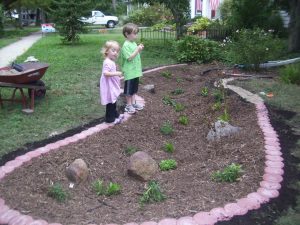by Stacy James, Water Resources Scientist
What is a rain garden?
A rain garden is a shallow, vegetated landscaping feature that captures excess rainwater and puts it to work. As the rain garden bed is slightly below the level of the yard, the garden acts as a shallow dish that holds the water for a short time so that it can instead soak into the garden soil. Well-designed rain gardens absorb 30% more water than turf lawns and will drain completely within a few days after an average storm.
What are the benefits of a rain garden?
Rain gardens have many benefits. First, it is an attractive addition to any yard. Both you and your neighbors will enjoy its beauty for years to come.
 In addition, rain gardens provide environmental benefits by improving water quality and promoting water conservation. Water that runs off hard surfaces, like your roof, and from your yard during rain events flows down the street collecting contaminants such as automobile fluids, yard fertilizers, and pet waste. This adds pollution to your local rivers because storm drain water is not treated before it enters your local rivers. For example, yard waste & fertilizers add excessive amounts of nutrients to rivers. This causes algae to grow and depletes oxygen in the water that fish and other aquatic life depend on. By collecting the excess runoff before it reaches the street, rain gardens reduce the amount of polluted water flowing into storm drains. Research has shown that the intensive installation of rain gardens in neighborhoods can greatly reduce storm water runoff and street flooding.
In addition, rain gardens provide environmental benefits by improving water quality and promoting water conservation. Water that runs off hard surfaces, like your roof, and from your yard during rain events flows down the street collecting contaminants such as automobile fluids, yard fertilizers, and pet waste. This adds pollution to your local rivers because storm drain water is not treated before it enters your local rivers. For example, yard waste & fertilizers add excessive amounts of nutrients to rivers. This causes algae to grow and depletes oxygen in the water that fish and other aquatic life depend on. By collecting the excess runoff before it reaches the street, rain gardens reduce the amount of polluted water flowing into storm drains. Research has shown that the intensive installation of rain gardens in neighborhoods can greatly reduce storm water runoff and street flooding.
The water retained in the garden soaks down into the soil, providing water for the garden plants as well as for the underlying water table. This minimizes the need for watering and helps conserve municipal water supplies. Finally, the native plants used in rain gardens provide habitat for birds, butterflies and other beneficial insects. Native plants also require less maintenance, particularly less watering, over time because they are adapted to the local soil and climate conditions.
What are the steps for creating a rain garden?
- Decide where you want the rain garden located and where it would be most effective in collecting the runoff from your property (i.e. close to a downspout).
- Design the garden. Determine the garden size and depth that will maximize the amount of runoff the garden receives. Garden shape is largely a matter of preference or available space.
- Select your plants. Choose moisture-loving species for the garden bottom and drought-tolerant species for the sides and berm. Selecting plants that are diverse in color, height, texture, and blooming time results not only in a more interesting display, but one that attracts a greater variety of birds and butterflies.
- Plant the garden. Planting time depends mostly on the size of your garden. For most gardens, a few people working together will be able to complete the project in a day. Ask your friends and neighbors for help; this is a great opportunity to spread the word about the benefits of rain gardens.
Where can I get more information?
If you would like more information about rain gardens or would like PRN to give your group a presentation on why rain gardens are beneficial and the basic steps of design and installation, please contact us (217) 344-2371 or info@prairierivers.org. Download our Rain Garden Brochure







